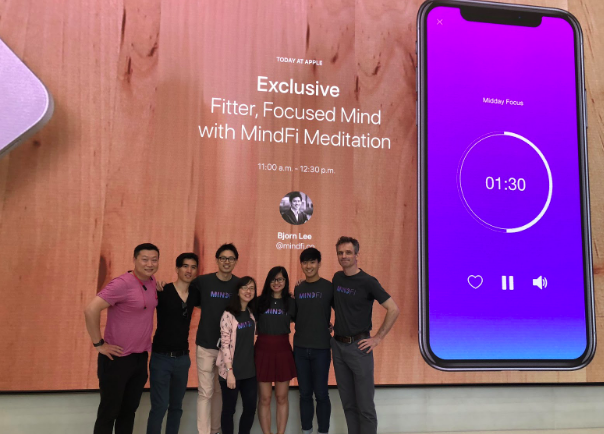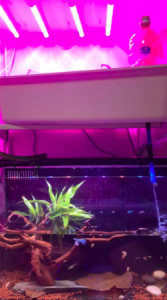All this without a cup of coffee

I am Bjorn Lee and I am the founder and CEO of MindFi, a smart meditation app for busy humans.
I have always had a love-hate relationship with meditation.
I was forced into it when I had chest pains in India, and I loved doing it there. But, I hated it when I went back to work.
Then, I spent the past seven years hacking my routine to build a habit.
Before MindFi, I was a product manager at both Zopim and Zendesk—the latter of which acquired the former. Prior to that, I founded an edtech startup in Silicon Valley and was a VC for three months before deciding on a life in the trenches.
Here’s a day in my life now.
8 am: Wake up, meditate, and cycle
I always snooze through two alarms before waking up.
The Apple Watch’s Breathe app is essential for its haptic feedback and heart rate variability tracking that gently jolts my wrist and body into motion.
Being as lazy as a fish, I immediately sit on my meditation chair for the next 10 to 20 minutes before I change my mind.
I never set a countdown; I just use a timer and stop on my own to prevent jarring shocks.
I end my meditations by thanking a bunch of people and saying encouraging words to myself.
Occasionally, I would jot them down in my journaling app, Day One, using the Tim Ferriss method.
And, if I still don’t feel good, I will cycle on my elliptical for 15 minutes which is my substitute for a caffeinated wake-up.
9 to 10 am: Plan to-dos with the team or attend meetings
I do a virtual “standup” on Slack with my team and check in on our to-dos for the day. Since half my team of six is overseas, I strive to ensure that I have ample face time with them.
This means that I only do external meetings at the start or end of my day to preserve my midday for team discussions or personal deep work.
I do this also because external meetings kill my productivity due to the commute time and the switch in mental gears.
This was inspired by Paul Graham’s essay “Maker Schedule, Manager Schedule.”
11 am to 1 pm: Deep work
I write my to-dos in chronological order and ensure some simple tasks are at the front.
This builds up a head of steam, which I would then use to move on to more challenging tasks like analyzing metrics, thinking through used cases for designs, or grooming the product backlog.
I use the Pomodoro timer in my MindFi app (also called “Deep Work”) and crank it up to the maximum two hours.
Then, I blast my trusty EDM music on my earphones and don’t come up for air until lunch.
I usually end my two hours with a five-minute meditation, which automatically comes up on my app.
1 to 1:30 pm: Lunch
I don’t eat breakfast, so this is my first and largest meal of the day.
My lunches are very quick affairs because I don’t want to break my rhythm. I also avoid lunchtime meetings because I have this notion that good food clouds the brain.
I always pick the shortest queue but make it an effort to walk to my lunch to get some exercise.
1:30 to 6 pm: Team huddles, power naps, and deep work

I usually check in with my team after lunch, especially when there are exploratory tasks that require investigation.
Timeboxing such tasks into half-day periods can help prevent overthinking and quicker communications across my remote team.
I am also a big believer of power naps and would buy sleep pods for my team if I could afford the luxury.
Also Read: 15 truths that actually transformed me into a happier entrepreneur
My energy crashes around 3:30 pm, so I will take a 15-minute nap lying down. Even if I can’t fall asleep, I try to focus on my breathing during this time. If I can’t nap, I take a 10-minute walk around the block or to a nearby park.
After my nap, I get my second wind and feel like my mind has done a hard reset. This means more deep work, which brings me to the end of the day.
6 to 8 pm: End-of-day standup and meetings
My window for external meetings opens up again at this time.
I would also do a virtual standup to update my to-dos for the day and, if time permits, deal with any contingencies or blockers for the next day.
8 to 12 midnight: Personal downtime
I don’t work during this period.
Also Read: How to manage energy and improve your productivity
This is reserved for dinner, social outings, my aquaponics farming habit, and reading or movie time.
My aquaponics hobby has given me a much-needed and (literally) natural respite from my tech startup career.

I enjoy tracking the growth of my plants and fish, managing the ecology, and geeking out on ways to scale to a sustainable food production system.
12 midnight to 1 am: Calls with advisers
This time is reserved for my calls to advisers in the US.
I rarely use this slot, but I am a late sleeper and have gotten used to it over time.
Some other notes:
- Every year, I go for a two-week, off-grid vacation where I don’t buy a SIM card, go to a small town, and talk to locals.
- I have my phone’s do not disturb mode permanently turned on unless I am expecting a call.
- I never turn on notifications on my laptop. My phone is distracting enough.
- I save half a day on weekends to do extended deep work with a giant screen and whiteboard. This allows me to really let my brain spill out its crap and reorganize things. I call it my personal defrag time.
—
e27 publishes relevant guest contributions from the community. Share your honest opinions and expert knowledge by submitting your content here.
The post From meditating to delegating; how I manage work-life balance as a startup founder appeared first on e27.
Source: E27

